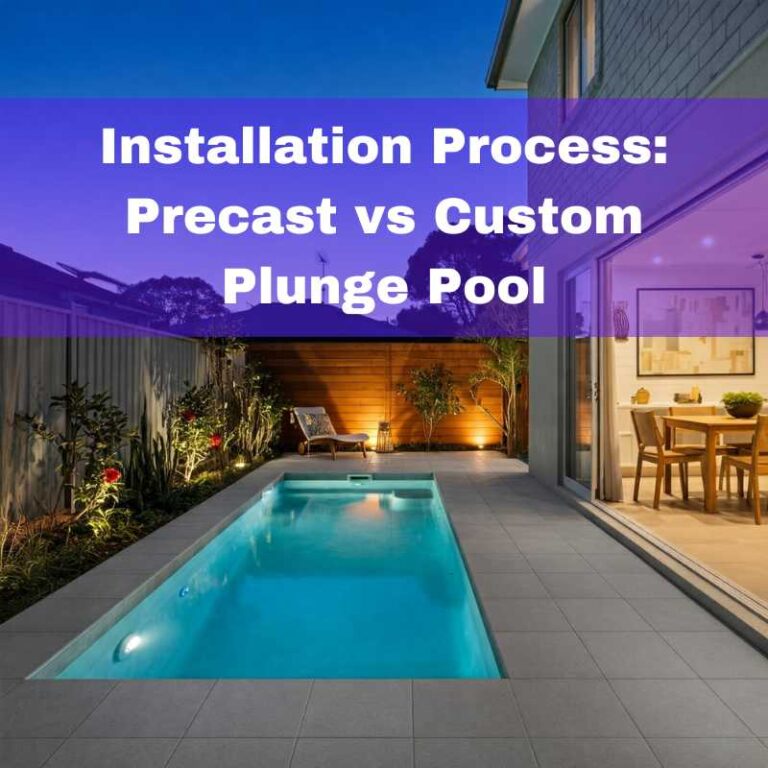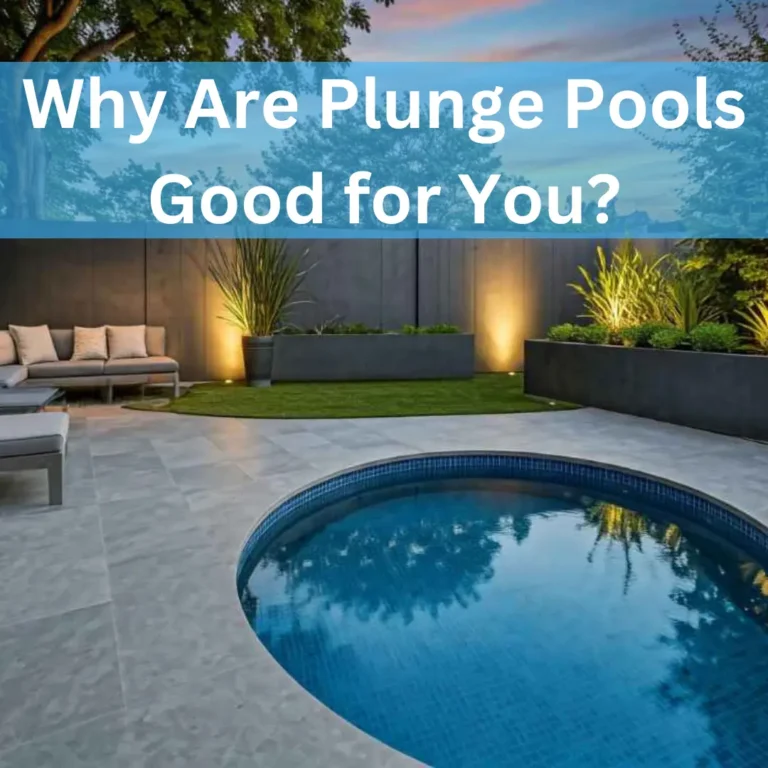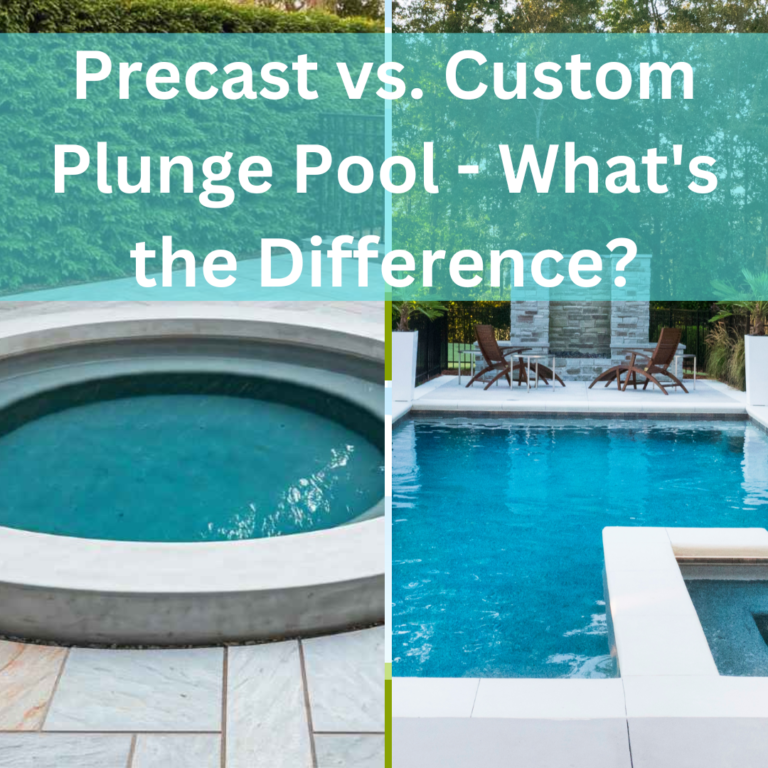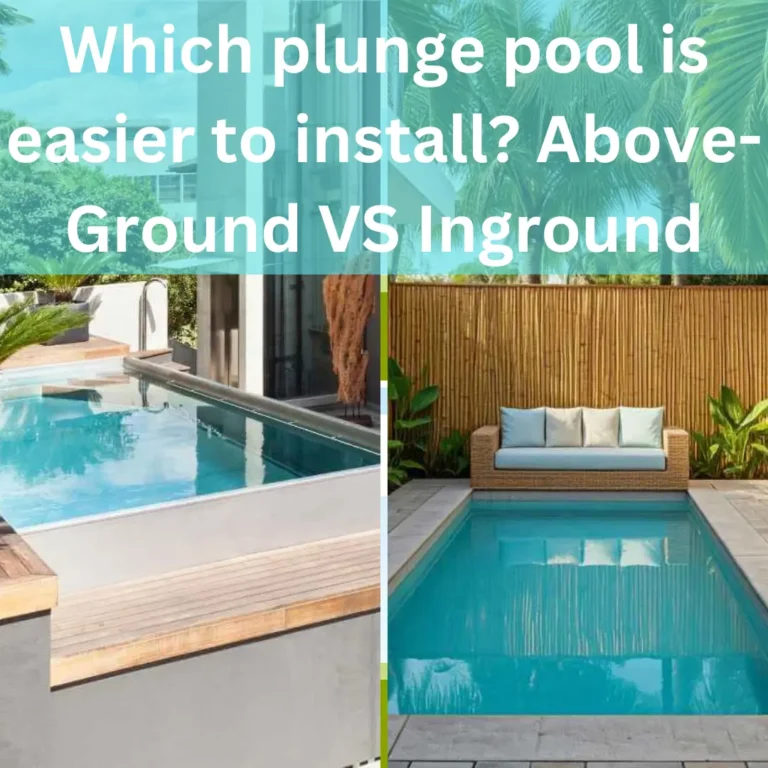Plunge Pools Sydney specialises in both above-ground and inground plunge pools, offering expert design and tailored solutions that align with your lifestyle and budget.
This article breaks down the key differences, with a focus on ease of installation, to help you choose the right plunge pool for your backyard.
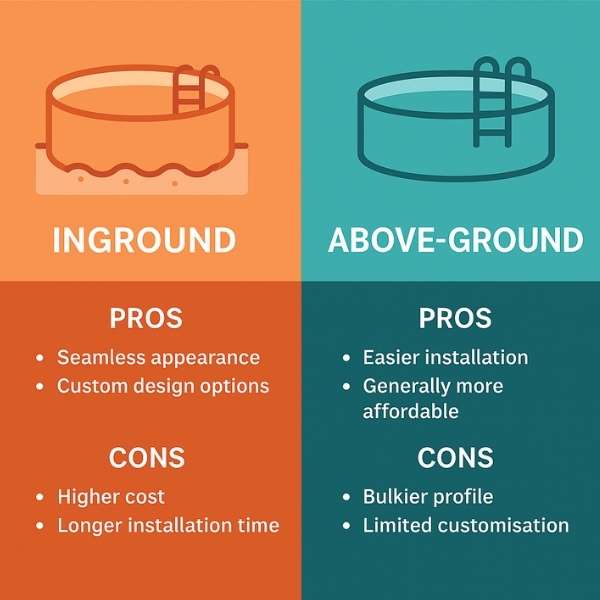
Table of Contents
ToggleWhat is an Above-Ground Plunge Pool?
An above-ground plunge pool is a compact, versatile pool designed for relaxation and cooling off, rather than swimming laps. It is placed above the ground, making it easier and cheaper to install compared to in-ground pools. These pools are ideal for small backyards, offering a stylish and eco-friendly solution for outdoor leisure.
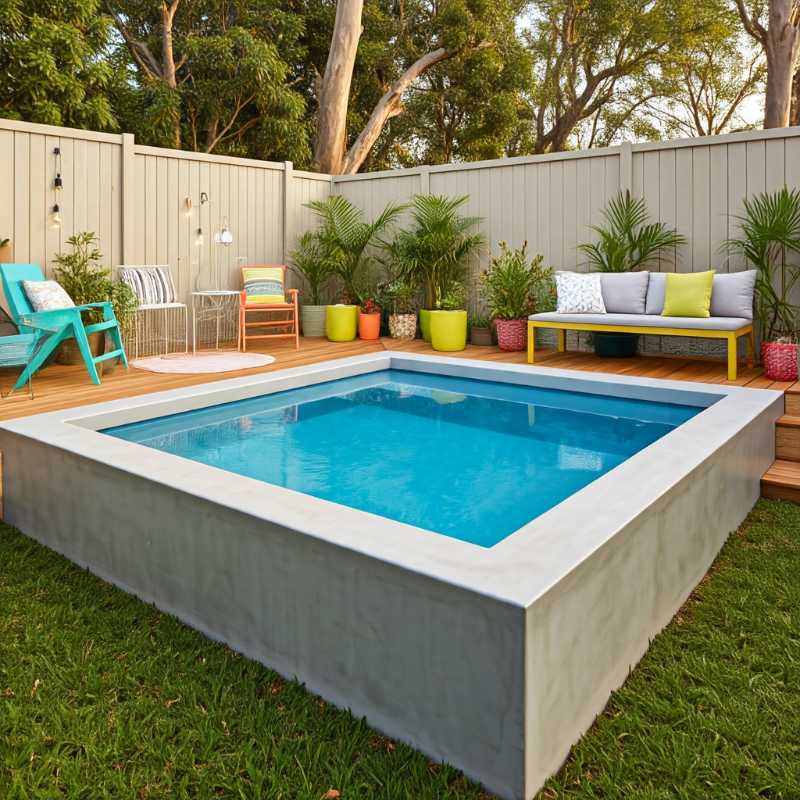
Above-Ground Plunge Pool Installation
Step-by-Step: Setting Up Your Above-Ground Plunge Pool
- Site Selection and Preparation
You’ll need to choose a flat, level spot in your yard, away from trees and power lines. Clear the area of any vegetation or debris, and lay down a protective ground cloth to safeguard the pool’s base. - Base Preparation
Create a solid foundation using either a sand base (about 5 cm thick) or a concrete slab. Ensure it’s perfectly level for the pool’s stability. - Pool Assembly
This is where you might want to call in a mate or two for help. You’ll assemble the pool frame according to the manufacturer’s instructions, typically using metal or resin components. - Wall and Liner Installation
Install the pool wall, usually a single piece of metal that wraps around the frame. Then, carefully fit the pool liner, smoothing out any wrinkles for a proper fit. - Equipment Setup
Set up the pool’s plumbing and filtration system, including the skimmer, return jets, and necessary pipes. Remember, all electrical work must be done by a licensed electrician. - Filling and Chemical Balance
Fill your pool with water, keeping an eye out for any leaks. Once full, balance the water chemistry using the right amount of chlorine and other chemicals. - Safety Features
Install compliant pool fencing and a self-closing, self-latching gate as required by Australian pool safety law.
Quick Setup Case
“Mark from Newtown shares how he and a friend installed their plunge pool over a weekend, saving on labour and completing the project in just 2 days.” – We prepped the base on Saturday morning and had the pool filled and balanced by Sunday evening—it was surprisingly straightforward.
Cost Considerations
Above-ground plunge pools have installation costs ranging from $5,000 to $15,000, depending on size and features.
Ready to install an above-ground plunge pool?
Contact us today for expert advice and a custom quote.
Contact us now ➔What is an Inground Plunge Pool?
An inground plunge pool is a small swimming pool that’s built into the ground, similar to a traditional inground pool but on a smaller scale. These in-ground pools can be made of concrete, fibreglass, or vinyl.
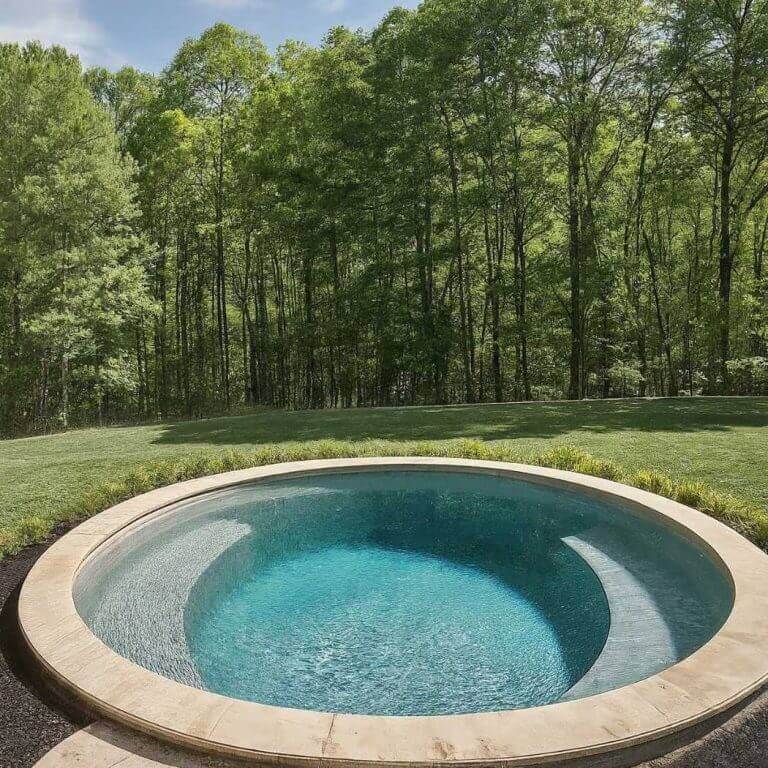
Inground Pool Installation: What the Process Looks Like
- Planning and Approvals
Before you start, you’ll need to obtain the necessary building permits from your local council. It’s wise to engage a building certifier to ensure your project complies with the Building Act 1975 and associated standards. - Site Preparation
After contacting Dial Before You Dig to identify underground utilities, an excavator will dig a hole for your pool. The area will be laser-levelled and filled with about 45 centimetres of crushed stone for stability. - Pool Delivery and Placement
Your precast plunge pool will be delivered by a flatbed truck and carefully placed into the excavated site using a crane. - Plumbing and Electrical Work
Install the pool’s plumbing and electrical systems, including filtration pipes, pool light cabling, and a hydrostatic valve. Remember, all electrical work must be done by a licensed electrician. - Equipment Installation
Set up the pump, filter, and optional features like heating systems or automation panels. - Backfilling and Concrete Work
Fill the space around the pool with suitable material for stability, and pour any concrete surrounds. - Safety Features
Install compliant pool fencing and a self-closing, self-latching gate as required by Australian pool safety law. - Landscaping and Finishing Touches
Add decking, paving, outdoor furniture, or other features to complete your backyard oasis. - Pool Filling and Chemical Balance
Fill your pool with water and balance the water chemistry for safe swimming. - Final Inspection
A building inspector will check that your pool meets all required standards, ensuring it’s ready for you to enjoy. If additional inspections are needed, you’ll need to contact your local council or a private certifier to arrange them.
Cost Considerations
Inground plunge pools have installation costs that typically range from $20,000 to $50,000, depending on materials and complexity.
Thinking about going inground?
Speak to our team to explore design options and site compatibility.
Speak to our team now ➔Plunge Pool Cost Comparison: Above-Ground vs Inground
| Factor | Above-Ground Plunge Pool | Inground Plunge Pool |
|---|---|---|
| Initial Purchase Price | $20,000 – $30,000 | $20,000 – $30,000 |
| Installation Cost | $1,000 – $5,000 | $5,000 – $15,000+ |
| Ongoing Maintenance Costs (per year) | $500 – $1,000 | $1,000 – $2,500 |
| Excavation Required | Minimal to none | Significant (adds to cost) |
| Customisation Options | Limited | Extensive |
| Durability | 30+ years | 30+ years |
| Impact on Property Value | Minimal increase | Potential significant increase |
This table provides a comparison of costs and other factors between above-ground and inground plunge pools in Australia. It’s important to note that these figures are estimates and can vary based on location, specific design choices, and local market conditions. The costs are presented in Australian dollars.
Above-ground plunge pools are cost-effective and quick to install, making them suitable for many spaces. In contrast, inground plunge pools provide enhanced durability, customisation options, and potential property value benefits. Both are great choices depending on individual priorities.
Remember that additional costs such as council approval fees, fencing requirements, and optional features like heating or lighting systems may also impact the overall cost of your plunge pool project.
While above-ground models may seem cheaper, homeowners often invest more in decking or aesthetics to match an inground look. Inground models, though pricier, can offset costs with long-term home value boosts.
Not sure which pool is right for your space and budget?
Use our Plunge Pool Cost Calculator to get a personalised estimate in minutes!
Get Your Instant Pool Estimate ➔Installation Ease Above-Ground VS Inground
Let’s take a look at how the two types of plunge pools compare in terms of installation ease:
| Aspect | Above-Ground Plunge Pool | Inground Plunge Pool |
|---|---|---|
| Time | Faster, often completed in a few days | Longer, can take weeks |
| Labour | Less labour-intensive | Requires more skilled labour |
| Complexity | Simple installation | More complex, involving excavation and structural work |
| Flexibility | Easy to relocate or modify | Permanent installation, less flexible |
| Weather Dependence | Less affected by weather | Weather can delay installation due to excavation requirements |
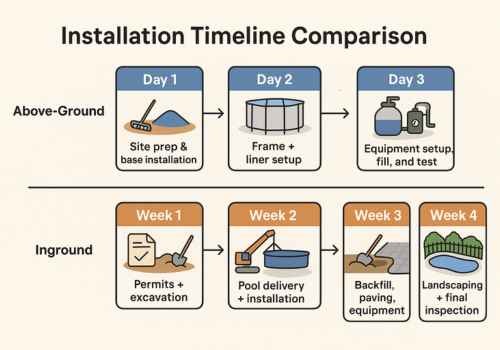
Factors Affecting Installation Ease
Several factors can influence how easy it is to install each type of plunge pool:
| Factor | Above-Ground Pool | Inground Pool |
|---|---|---|
| Maintenance Requirements | Easier to maintain | More complex maintenance due to plumbing and filtration systems |
| Durability and Lifespan | Typically shorter lifespan | Longer lifespan with proper care |
| Potential for Future Upgrades | Limited options | Easier to customise or upgrade over time |
| Impact on Property Value | Lower impact on property value | Can increase property value due to its permanent, upscale nature |
| Environmental Impact | Typically less environmentally intensive | Can have a higher environmental impact due to excavation and materials used |
| Safety Considerations | Easier to secure and modify for safety | Requires more safety considerations due to depth and design |
One overlooked factor is delivery logistics—above-ground kits are easier to maneuver into tight urban spaces compared to large inground shells requiring cranes.
Energy Use and Seasonal Comfort: What Most Homeowners Don’t Realise
Most people don’t think about heat loss until they’re already in the water. But how your pool holds temperature makes a big difference—not just to your comfort, but also your energy bill.
Inground plunge pools tend to do a better job here. Because they’re surrounded by earth, they stay naturally insulated. Add a solar or electric heater, and they can hold warmth well into the cooler months—without guzzling power.
Above-ground pools, on the other hand, are exposed to air on all sides. That means they lose heat more quickly, especially overnight or on windy days. You’ll need to top up the heat more often just to keep things comfortable.
So what can you do?
Seasonal Comfort Tips:
Inground Pools: With proper heating, these can be used almost all year round—especially if you get good sunlight or invest in efficient equipment.
Above-Ground Pools: Add a thermal blanket to trap warmth and consider windbreak screens to block chilly breezes. These small changes can help stretch your swimming season into spring and autumn.
Before You Dig: What Our Installers Wish Every Homeowner Knew
Installing a plunge pool isn’t just about choosing a shape and digging a hole—it’s about avoiding problems you didn’t see coming. Here’s what our Sydney installers have learned from years on the job:
- Start with a solid base. If the ground isn’t perfectly level, your pool won’t sit right. We’ve seen above-ground pools shift or bow because the foundation wasn’t properly compacted. Don’t rush this step—it’s the backbone of your whole setup.
- Drainage matters. For inground pools, water pressure under the surface can build up fast—especially after heavy rain. Without a proper drainage plan, that pressure can crack your shell or shift the base. Always include drainage in the early design.
- Think about the sun. Want a warmer pool and lower heating costs? Position it to face north if you can. It’s a small design choice that pays off every day you swim.
- Talk to your council—early. Many delays we see happen not during construction—but before it even starts. Every council has its own rules, and getting caught off guard can mean weeks of waiting. Get advice or approvals up front.
- Don’t go too big. It’s tempting to max out your space—but bigger isn’t always better. We’ve had clients wish they’d left room for a deck or garden. A well-placed small pool can feel more luxurious than a large one that overwhelms your yard.
Conclusion
Choosing between an above-ground and inground plunge pool isn’t just about budget—it’s about how you live. Above-ground pools are the quicker win. They’re simpler to install, easier on the wallet, and can slot into tight spaces with minimal fuss. If you’re after a fast, practical way to cool off without tearing up your backyard, this might be your answer. Inground pools, on the other hand, are a longer game. They take more time and money upfront—but give you flexibility in design and a seamless, built-in look that can boost your home’s value over time.
There’s no one-size-fits-all. Think about how you’ll use the space, what suits your lifestyle, and how much time you’re willing to invest—both now and down the track.
After this, take a look at our guide on precast vs custom plunge pools—it’ll help you make an even more informed call.
Still undecided? Let us help.
Contact Plunge Pool Sydney to get tailored guidance based on your property and goals.
Contact us ➔To help you even more to decide whether plunge pools are for you, check out our article about why plunge pools are good for you.
People Also Ask
What are the most common challenges faced during installation for each type?
For above-ground pools, ensuring a level base and proper support for the pool structure are key challenges. Inground pools face challenges such as excavation difficulties, potential underground utility conflicts, and weather-related delays during construction.
What factors should I consider when choosing between above-ground and inground plunge pools?
Key factors include your budget, available space, installation timeline, desired level of customisation, and local council regulations. Above-ground pools are great for affordability and quick setup, while inground pools are better suited to those seeking a permanent, custom-designed option.
Are there differences in maintenance between the two?
Maintenance requirements are generally similar, though inground pools might require more effort due to their size and any additional landscaping. Above-ground pools are often easier to access for cleaning and repairs.
How do local regulations typically differ for above-ground vs inground plunge pools?
Local regulations often treat above-ground and inground pools differently. Inground pools typically require more extensive permits and inspections. Above-ground pools may have less stringent requirements, but still often need to meet safety standards, especially regarding fencing. Always check with your local council for specific regulations in your area.

